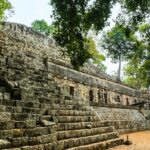How To Visit The Tikal Mayan Ruins In Guatemala (+Map)

Visiting the Tikal Mayan Ruins in Guatemala is a journey into the heart of an ancient civilization surrounded by lush jungle. Tikal, a UNESCO World Heritage Site, is one of the most impressive and well-preserved Mayan archaeological sites. Here’s a comprehensive guide on how to visit Tikal, including a map to help you navigate the site.
Getting to Tikal
From Flores
Flores, a picturesque island town on Lake Petén Itzá, is the primary base for trips to Tikal.
- By Bus:
- Shuttles: Tourist shuttles leave from Flores to Tikal several times a day. The journey takes about 1.5 hours and costs approximately $10-15 USD round trip.
- Public Bus: Public buses (also called “colectivos”) are a cheaper option, costing around $5 USD one way. The trip can take a bit longer and might be less comfortable.
- By Car:
- Renting a car in Flores is another option, giving you more flexibility. The drive to Tikal is straightforward and takes about 1.5 hours.

From Guatemala City
- By Flight: The fastest way is to fly from Guatemala City to Flores (Mundo Maya International Airport). The flight takes about 1 hour. From Flores, follow the above options to reach Tikal.
- By Bus: Overnight buses run from Guatemala City to Flores, taking around 8-10 hours. Once in Flores, you can take a shuttle or bus to Tikal.
Entrance Fees and Hours
- Entrance Fee: Approximately $20 USD (150 GTQ) for foreigners.
- Opening Hours: 6 AM to 6 PM daily.
Guided Tours
Hiring a guide is highly recommended to enhance your understanding of Tikal’s history and significance. Tours can be arranged in Flores, at the park entrance, or in advance online. Costs vary, typically around $30-50 USD per person.

Map of Tikal
Here’s a simple map highlighting key structures and areas within the Tikal complex:
- Grand Plaza: The central area flanked by Temple I (Temple of the Great Jaguar) and Temple II (Temple of the Masks).
- Temple I: The iconic pyramid rising 47 meters (154 feet), built as the tomb of Ah Cacao, a prominent ruler.
- Temple II: Offers great views of the Grand Plaza and Temple I.
- North Acropolis: A complex of smaller pyramids and tombs adjacent to the Grand Plaza.
- Central Acropolis: A maze of rooms and courtyards believed to be residential and administrative buildings.
- Temple IV: The tallest structure at Tikal, standing at 70 meters (230 feet). Climbing to the top provides panoramic views of the jungle canopy and other temples.
- Temple V: Another impressive pyramid, slightly away from the central area.
- Lost World (Mundo Perdido): An older complex featuring a large pyramid and several smaller structures.
What to Bring
- Comfortable Clothing: Lightweight, breathable fabrics. Long sleeves and pants can help protect against insects.
- Hiking Boots or Sturdy Shoes: Essential for walking on uneven terrain.
- Sun Protection: Hat, sunglasses, and sunscreen.
- Insect Repellent: The jungle environment has many mosquitoes.
- Water and Snacks: Stay hydrated and bring energy-boosting snacks.
- Camera: To capture the stunning ruins and wildlife.

What to Expect
Wildlife
Tikal is located in a national park teeming with wildlife, including howler monkeys, spider monkeys, toucans, parrots, and coatimundis. Keep your eyes and ears open for these creatures as you explore.
Climate
The weather can be hot and humid, especially from March to May. The rainy season is from June to October, but rain can occur year-round. Morning visits are cooler and often less crowded.
Suggested Itinerary
- Early Morning: Arrive at the park entrance by 6 AM to catch the early light and avoid the midday heat.
- Grand Plaza: Start your visit here to see Temples I and II.
- North and Central Acropolis: Explore these areas next for a sense of the city’s residential and administrative functions.
- Temple IV: Climb to the top for a panoramic view.
- Lost World: End your visit here, where you can explore a different part of the site away from the main crowds.
Additional Tips
- Stay Overnight in the Park: For a more immersive experience, consider staying at one of the lodges near the park entrance, such as Jungle Lodge or Tikal Inn. This allows for early access and the possibility to join sunrise or sunset tours.
- Respect the Site: Tikal is an important cultural and historical site. Follow all park rules, stay on marked paths, and do not climb structures unless explicitly allowed.
Conclusion
Visiting the Tikal Mayan Ruins offers a fascinating glimpse into ancient Mayan civilization set amidst a stunning natural environment. With proper preparation and an early start, you can fully appreciate the beauty and historical significance of this incredible archaeological site in Guatemala.









